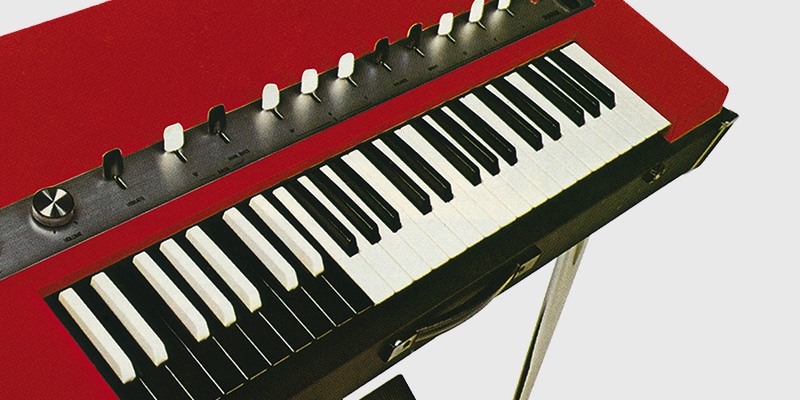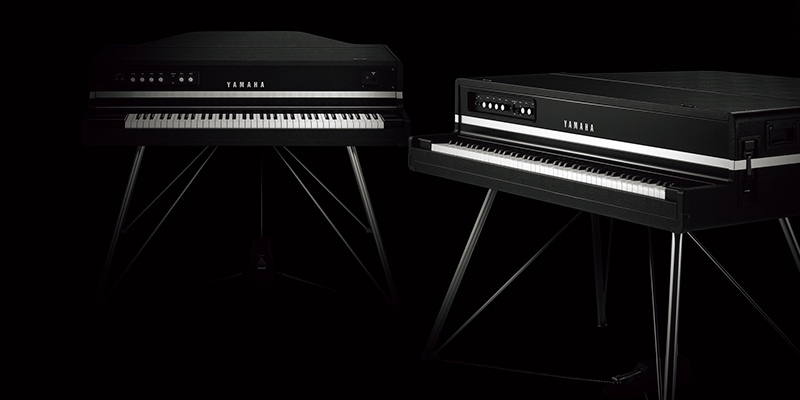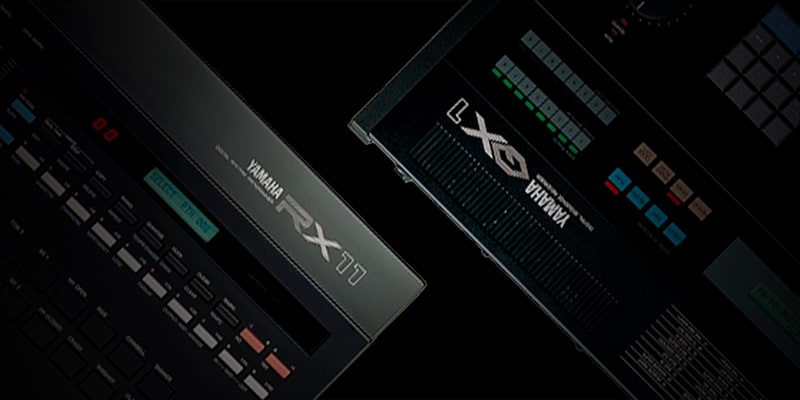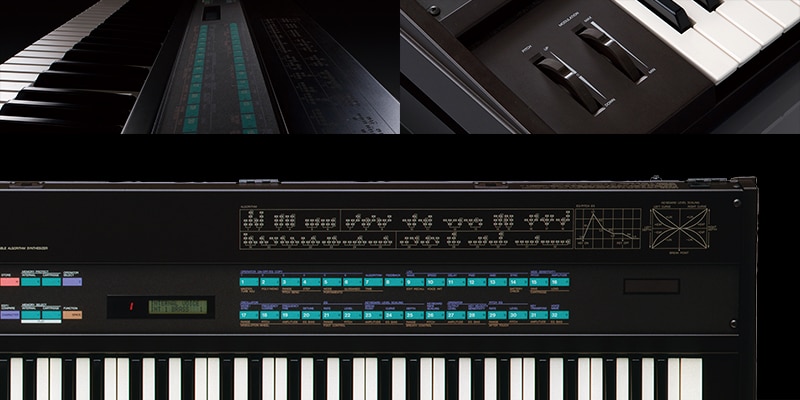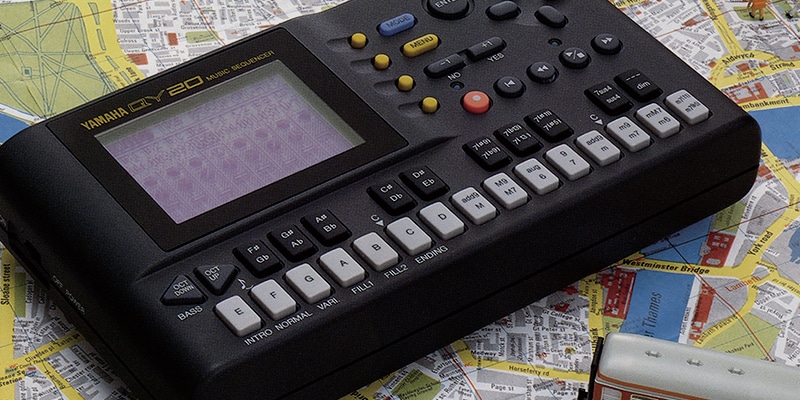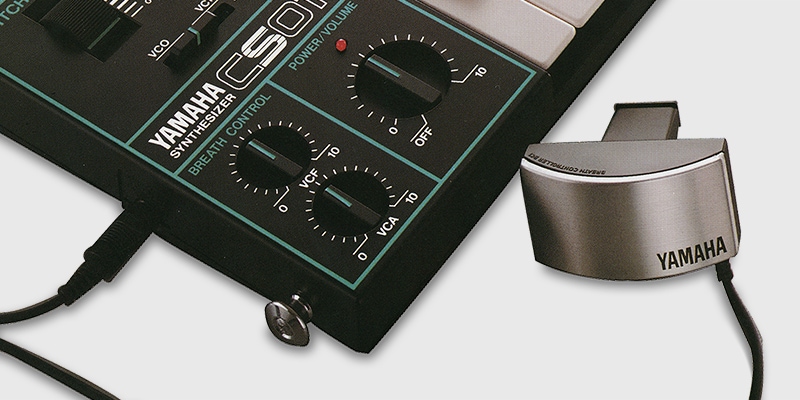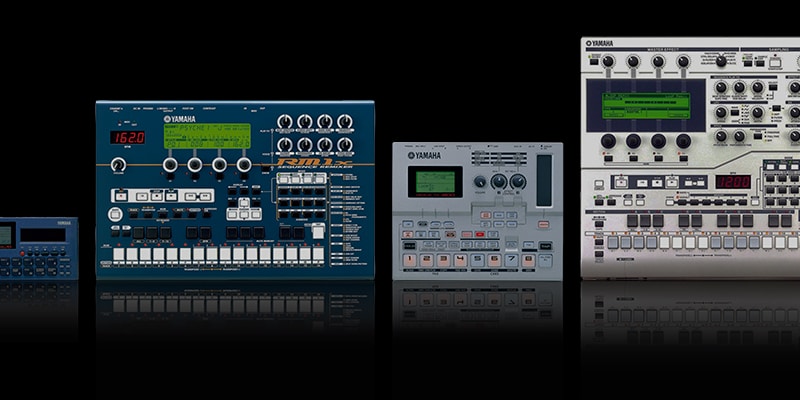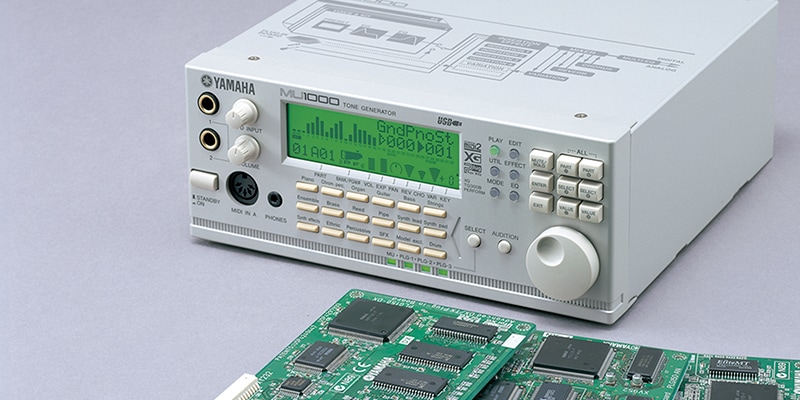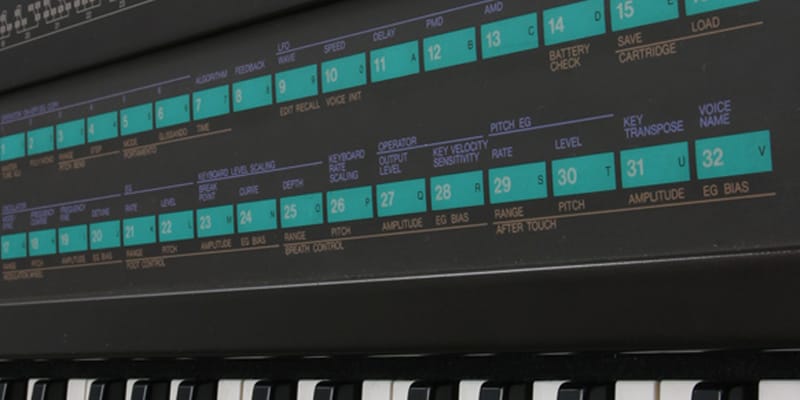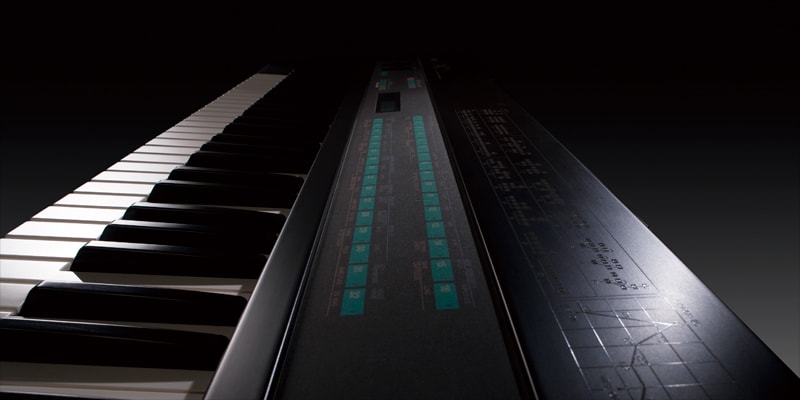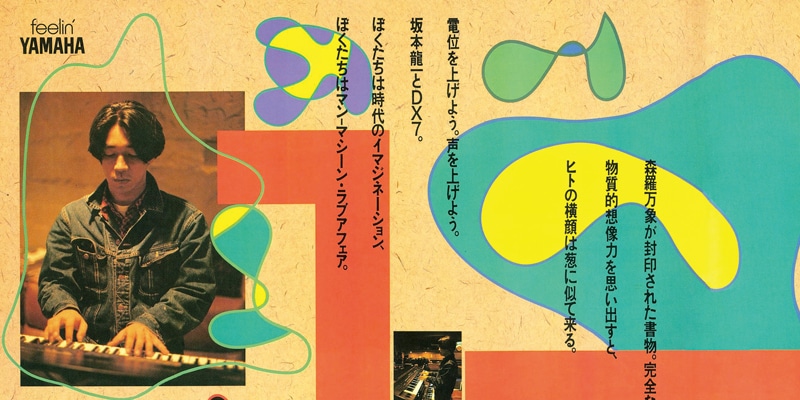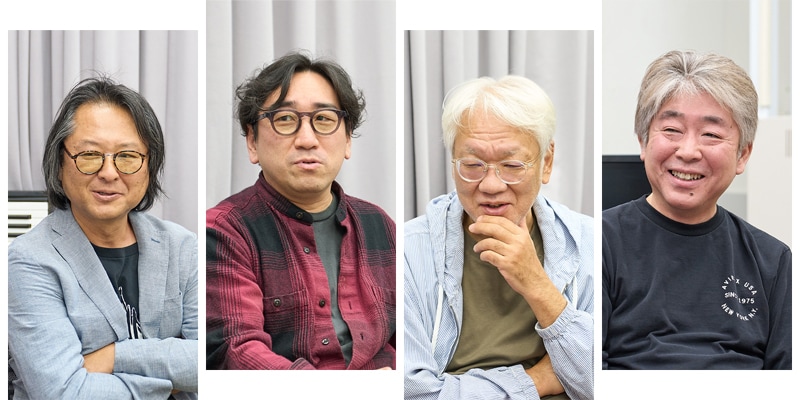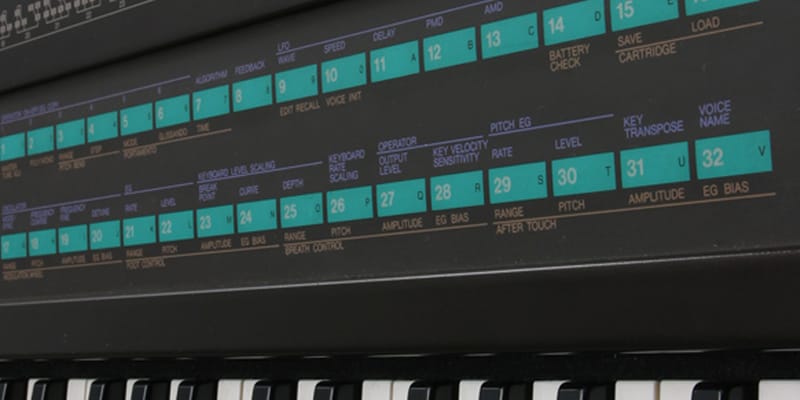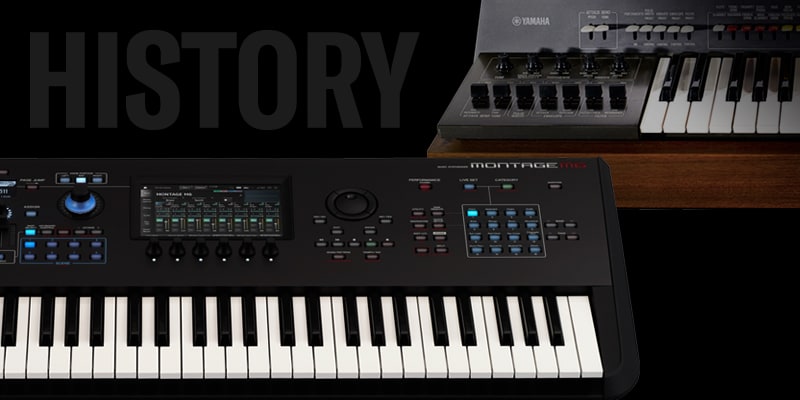Sakamoto and Yamaha Synthesizers
The DX7 Connection
At the start of his musical career as a member of legendary Japanese band Yellow Magic Orchestra (YMO), Ryuichi Sakamoto employed synthesizers as a means of unbridled sound creation, but he rarely used Yamaha instruments back then, preferring foreign synths in his setup instead. It was only when he went solo after the breakup of YMO that he became a committed Yamaha user.
Sakamoto began using the DX7 while working on his solo album Illustrated Musical Encyclopedia of October 1984. Having started in late 1982, recording and production of the album took nearly two years to complete, during which time the famous synth was released. Impressed by the sound quality, editing flexibility, and expandability of the instrument’s innovative FM approach to tone generation, Sakamoto started to actively choose it for both studio and stage applications. He had an excellent understanding of how the DX7 actually produced sound, likening its algorithms to banks of polymodulators stretching out in all directions.
The DX7 totally changed the way that Sakamoto made music. In the past, he had tended to lock himself away in the studio for many long hours and days at a time, painstakingly building sounds and songs. Now, he set up a DX7 in his home for demos and pre-production.
Mari Iijima’s debut release Rosé, which Sakamoto produced, was the first album on which he used one, and it now serves as a great reminder of how the synth sounded immediately after it burst onto the scene.
In Futurista of 1985, the album’s futuristic sound was exemplified by Sakamoto’s extensive use of FM synths such as the DX5 and TX816 in addition to the DX7. The FM electric piano on Kodo Kogen (Loess Plateau) and the FM bass on G.T. are great examples of the FM voices he chose for this work. In fact, Sakamoto was so smitten by the DX7 at the time that he declared it the only synth he needed (that said, he did in fact require other digital instruments such as the Fairlight and Emulator for sampling). Incidentally, Rittor Music released a ROM expansion cartridge for the DX7 containing many of the voices that Sakamoto used for this album.


One year later in 1986, Sakamoto’s performances on his Media Bahn Live national concert tour were fueled by a bank of DX Series synths. This was also the first tour anywhere in the world to feature a MIDI piano. And it was around this time that Sakamoto and Yamaha started to cooperate more closely. Joint publicity with the tour promoter helped to enhance the image of a close working relationship, and the partnership continued on subsequent tours with his publicity material including advertisements for our products. Our DX7IIFD took on the role of main keyboard for his Neo Geo Tour of 1987, resulting in the distinctive sound of the more polished second-generation DX becoming very prominent. On a side note, the DX7 and DX7II had different rear-panel logos, so they can be told apart at a glance in photographs of Sakamoto performing.
Ties with Yamaha and a Deep Understanding of Digital Instruments
In the nineties, as we moved on from the successes of the DX Series, Ryuichi Sakamoto assisted Yamaha in many ways, advising us not only on the development of synthesizers but also digital mixers and other new technologies.

Rewinding a little to 1985, we had established R&D Tokyo in Shibuya’s Dogenzaka district with the intention of beefing up our research and development of digital musical instruments, and the project was later expanded with similar operations in London and New York. Inspired by the achievements of the DX7, an official channel was established to convey feedback from performing artists and other market participants to our development team at Yamaha HQ in Hamamatsu.

Sakamoto also participated in the interactive program and visited us at both R&D Tokyo and Hamamatsu to share ideas with designers, developers, and other members of the Yamaha team. For example, when we introduced the SY77 in 1989, he really loved the coupling of warm, analog-like tones with the type of futuristic sound that only a new synth can deliver, and he suggested that professional musicians could help to provide voices worthy of such a capable instrument. This was, in fact, a prescient foretelling of the nineties’ era of PCM voice expansion packs. Meanwhile, the powerhouse of the SY Series—the SY99—contributed both to Sakamoto’s solo album Heartbeat, and the album Technodon, which he made as part of the reformed YMO.
The late Shigenori Tanaka, first manager of Yamaha R&D Tokyo, played a key role as liaison between Sakamoto and the company. In reality, the two had known each other since the seventies when Sakamoto, still a relatively obscure session musician, frequented the Yamaha Shibuya store where Tanaka worked at the time. Tanaka was also well known as first manager of the Japanese band Garo, which released the famous single Gakuseigai No Kissaten (Student-Quarter Coffee Shop), and he got on very well with artists on a personal level. While rarely speaking in depth with Sakamoto about product planning and development, Tanaka did serve as a go-between with Yamaha R&D and Sales, and his real talent lay in conveying Sakamoto’s conceptual requests and suggestions in such a way that our designers and developers could make them a reality. On the flip side, it was always his role to bring Yamaha’s vision back to Sakamoto when it came to research, planning, and development of new approaches to tone generation and other original product concepts.
In parallel with this support on the musical side, Tanaka also arranged for Sakamoto to feature in a wide range of brand building and sales promotion activities for Yamaha electronic instruments and sound-reinforcement equipment, and this is testament to the strong relationship of mutual trust between the two.

On January 23, 1997, at a concert held in Yokohama Arena for the last day of the “Mitsubishi Electric Super Selection ‘f’ Ryuichi Sakamoto PLAYING THE ORCHESTRA 1997” tour, Yamaha made the first public trial of its “Internet MIDI Live System,” with the full cooperation of Sakamoto. This was the first system in the world to broadcast performance data from a live concert while it was being performed, at a concert held in Yokohama Arena, and saw Tanaka take a major role as the project leader responsible for coordinating the collective power of the Yamaha Group.

Sakamoto and Tanaka also worked with the Japan Musical Instruments Association, an organization consisting of 785 musical instrument-related companies across Japan, to establish the School Music Revival Fund, which supported students living in areas affected by the 2011 Tohoku earthquake and tsunami through the repair and replacement of musical instruments among other activities. The Tohoku Youth Orchestra, which was established thanks to the efforts of this project, is still active today. Yamaha awarded Shigenori Tanaka a distinguished service award on the 10th anniversary of the creation of the fund.
Jumping forward now to 1993, Sakamoto was visiting Yamaha HQ in Hamamatsu for a planning meeting on a custom-made piano, and while there, was asked to share his thoughts on a pair of related instruments that we had newly developed—the VL1 and VP1. These synthesizers featured physical-modeling tone generators that combined the best of Yamaha technology at the time, and Sakamoto was impressed by the level of expression achievable when playing with this form of synthesis. Not only that, but he was also intrigued by how sounds could be modified in real time by moving many parameters at once, and this concept of tone morphing provided inspiration for his later sound-creation activities. In conclusion, Sakamoto noted that the instruments would also be well suited to modern music applications. This and other opportunities for direct interaction were great motivators for Yamaha engineers.

As the popularity of personal computers grew steadily through the latter half of the nineties, the desktop music craze did not go unnoticed by Japanese synth makers. Here at Yamaha, we explored the possibilities of musical expression using PCs and the Internet, notable releases being MIDPLUG, a browser plugin that allowed web sites to play music, and the XG common format for synth voices. Sakamoto also recognized the potential of the Internet from its earliest days, and he helped to popularize XG synths.
In the spring of 1997, Yamaha ran a newspaper ad featuring three of Japan’s leading synth artists at the time—Sakamoto, Tetsuya Komuro, and Isao Tomita. It went on to take top prize in the Japan Newspaper Advertising Awards that year.

When we released the EX5 as our next-generation flagship synthesizer in 1998, Sakamoto had been involved in development right from the get-go at special appraisal sessions. Like many others, he was a fan of the versatile PCM tone generators that represented the mainstream at the time, while also cognizant of the expressive limits of this approach to sound creation. As such, he was thrilled to have as many as five hybrid tone-generation systems at his disposal in the EX5, and he regularly put the instrument’s sampler functionality to use with control knobs and the ribbon controller in both recording and live performance. Sakamoto also made use of the EX5’s newly developed AN tone generator in recording sessions, and he loved the feel of its 76-key FS keyboard when put to use as studio master. As a sign of his appreciation for this series—and particularly the later-released silver EX5S—Sakamoto worked with us on several different advertisements, all the photos for which were shot in New York, where he was based at the time.

It should be noted that many users of Yamaha synthesizers were calling out for user-interface enhancements around then. The time-honored approach to panel arrangement was still appreciated by some, but many others said we needed to follow Apple’s lead and embrace a bold new imaginative vision.
From Back to The Basics to the Twilight Years

Yamaha synthesizers underwent a major change as we approached the end of the nineties with the release of our so-called “piano synths”. Long sought after by keyboardists, these instruments not only boasted highly realistic piano voices but felt just like the real thing to play. The story of their development will have to wait for another day, but suffice it to say that Ryuichi Sakamoto put the S80 of 1999 to widespread use. He nearly always played one at venues that could not accommodate an acoustic piano, which was instrumental in boosting the profile of our S Series.
This also coincided with Sakamoto returning to the sound of the piano for his 13th solo album BTTB (Back to the Basics), released in November 1998, as well as Ura BTTB (Another Side of BTTB) of the following year. A fan of the sound and feel of the S Series piano synths, he used them devotedly for many years, right from the S80 to the later S90 and S90ES models.

Sakamoto was just as enthusiastic about our MOTIF Series as he had been about the DX Series of instruments, and in 2003—the 20th anniversary of the DX7—he even fronted an ad campaign for the powerhouse instruments as a brand ambassador for the Yamaha synthesizer. Over four generations from the original MOTIF of 2001 to the MOTIF XF of 2010, this series evolved in an unforced, intuitive way, so Sakamoto and other musicians could easily adapt to changing models. He often insisted on Motifs with the 76-key FS keyboard because it felt so right to his hands, and he was regularly seen performing with one of them sitting proudly atop his grand piano. What’s more, when YMO again re-formed in 2007, the MOTIF XS and XF were frequently part of their live setup.
In 2010, Sakamoto played a CP1 flagship stage piano at an event held to commemorate the reopening of the Yamaha Hall in Ginza following refurbishment. In an unusual arrangement with two MIDI-connected grand pianos at the sides and the CP1 in front, he used the latter not for piano sounds but mainly for the exquisite electric-piano tones of our new spectral-component-modeling tone generator. At this event, he emulated the experience of playing classic electric pianos by way of demonstration, explanation, and performance. And in the latter half of the show, he even broke character and made the audience laugh by playing with the light switch for the Yamaha logo on the instruments’ rear panel.


Sakamoto was also one of the first to use the MONTAGE in actual recording, taking a prototype with him into Red Bull Studios Tokyo. It was August 2015, and after recovering from oropharyngeal cancer the previous year, he was working on the movie score for Living with My Mother, which was close to release. Although the software installed on that prototype was far from complete, one of our designers did demonstrate the potential of the new Motion Control features—particularly the Super Knob and Motion Sequences. That was met with a series of probing questions that our staff members were hard pressed to answer right away. For example, Sakamoto wanted to know whether the audio tempo synchronization could track a naturally evolving tempo and if the envelope follower’s resolution was set to prevent it trying to follow the true waveform of very low-pitched input notes. They also had an in-depth conversation about how double stops and other special playing techniques for string and wind instruments could be handled by the Expanded Articulation (XA) function and Mega Voices—a unique feature of Yamaha synths that can reproduce the subtle nuances of acoustic instruments in a highly convincing way. The discussion covered a wide range of musical concepts extending beyond the realm of synthesizers, and our team was amazed by the extent of Sakamoto’s ingenuity and creativity.

In his latter years, Sakamoto regularly used the MONTAGE and CP88 as keyboard synthesizers for sounds other than vintage analog. And after his second cancer diagnosis in 2020, he commented on the CP88 that he had played regularly at his home in Japan, saying, “Yamaha let me borrow a synth piano that feels and sounds incredibly close to the real thing, so I use it to practice. I do adjust the velocity curve a little. The keys are heavier than those on most synths and closer to those of an acoustic piano.”
It is my firm belief that Ryuichi Sakamoto’s superb musicianship, a wealth of knowledge and imagination that made him a genuine pioneer, and his influence within the music industry have contributed greatly to Yamaha’s R&D, brand building, marketing, and sales. I have countless memories of working together with Sakamoto on synthesizers, planning and developing custom pianos, supporting many of his live performances, and recording his massive hit single Energy Flow. Above all else, though, I cherish the memory of his last recording session, held in Tokyo’s NHK Broadcast Center in September 2022. Mere words cannot express the majesty of his playing as he struggled with cancer, but I would like to think that the performances captured in the movie Ryuichi Sakamoto | Opus somehow convey that beauty. He passed away soon after on March 28, 2023 at the age of 71. In his memory, I will do my best to ensure that current and future generations continue to appreciate his life’s work.
Takanori Kojima



